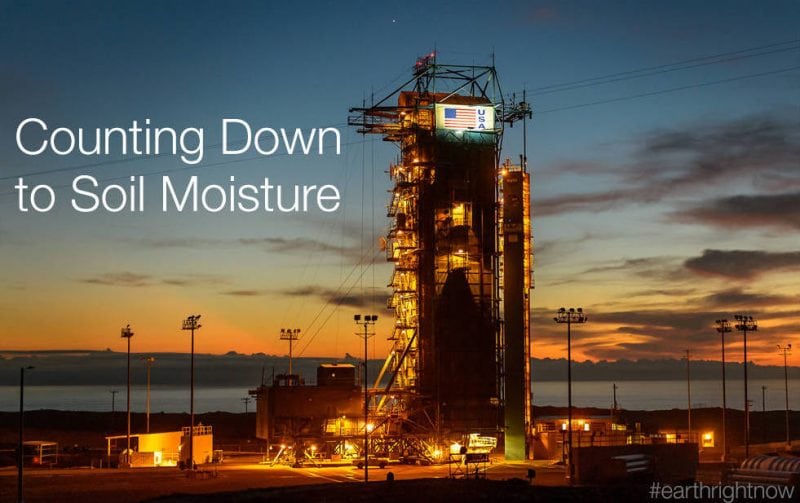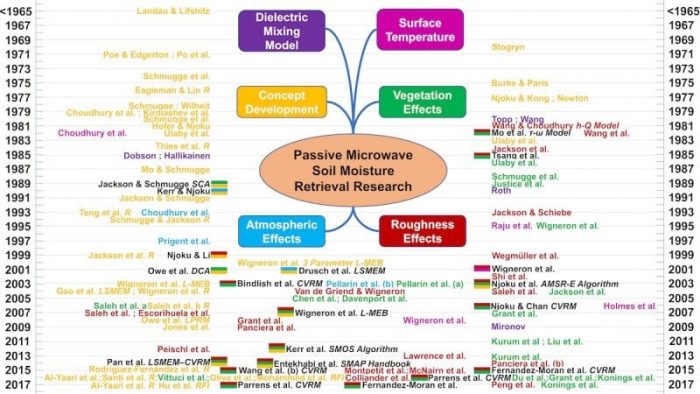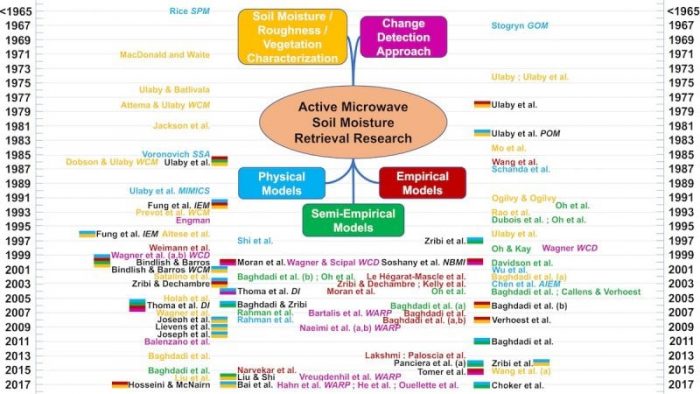
Soil moisture is an important land surface variable, which is present at land-atmosphere interphase and influences the hydrologic, atmospheric, climate, agricultural, and carbon cycles. Given the challenges involved in measuring the soil moisture at the local scale (heterogeneous nature of the soil, financial constraints etc.), microwave remote sensing has assisted the researchers in obtaining the soil moisture at the global scales.
Microwave remote sensing of the land surface processes has advantages over optical remote sensing such as least attenuation due to the atmosphere, and high temporal resolution among others. The microwave sensors can be categorized into two kinds, passive (where the Sun acts as the source of energy) and active (where the sensor sends a microwave signal and records the response) sensors. Each has their own pros and cons. With the advent of dedicated soil moisture missions European Space Agency (ESA)’s Soil Moisture Ocean Salinity (SMOS) sensor and National Aeronautics and Space Administration (NASA)’s Soil Moisture Active Passive (SMAP) sensor, there is an increased opportunity to involve soil moisture in several hydro-meteorological, climate and agricultural applications such as monitoring of floods and droughts, estimation of precipitation, crop yield assessment, and weather forecasting.
Last year, 2017, marks the four decades of research on microwave remote sensing of soil moisture. Signifying this milestone, a synthesis of four decades of research and development on the passive and active microwave soil moisture retrieval algorithms is provided. A retrieval algorithm is used to convert the satellite microwave measurements (brightness temperatures in the case of passive sensors, backscatter coefficients in the case of active sensors) into soil moisture. Generally, microwave measurements associated with L- (0.5 – 1.5 GHz), C-(4 – 8 GHz), and X- (8 – 12 GHz) frequency bands are sensitive to the dielectric constant of soil, which in turn gets influenced by variations in the moisture content of the soil.
It is interesting to note that the use of lower frequencies will improve our ability to retrieve soil moisture from greater depths. So, an L-band sensor, which is equipped currently in SMOS and SMAP missions, can retrieve soil moisture up to a depth of 5 cm. The microwave measurements intended to retrieve soil moisture have major and minor attenuations due to the presence of vegetation and atmosphere respectively. So, a retrieval algorithm generally attempts to separate the effects of these attenuations from the satellite measurement in order to estimate the signal that associated exclusively with the soil moisture. Over the past four decades, numerous airborne and field campaigns have assisted researchers to improve our ability to obtain high-quality soil moisture retrievals at global scales. In this review effort, the important developments that took place in the area of retrieval algorithms associated with passive and active microwave satellite sensors are presented. These developments are summarized in the form of figures, one each for passive and active microwave satellite soil moisture research.

Figure 1. Summary of the important developments of the passive microwave soil moisture research. Republished with permission from Elsevier from: https://doi.org/10.1016/j.advwatres.2017.09.006
In each of these figures, the entire area of research is categorized into important sub-fields. The passive microwave soil moisture research (Figure 1) is broadly classified into six fields, concept development of retrieval algorithms, dielectric mixing model, surface temperature, roughness effects, vegetation effects and atmospheric effects. The active microwave soil moisture research (Figure 2) is broadly classified into five fields, characterization of soil moisture, roughness and vegetation, physical models, semi-empirical models, empirical models, and change detection approach.

Figure 2. Summary of the important developments of the active microwave soil moisture research. Republished with permission from Elsevier from: https://doi.org/10.1016/j.advwatres.2017.09.006
The numbers on the sides indicate the year during which a particular paper got published. Each citation is color coded so as help the reader to select the set of references that belong to a particular sub-field. For example, if one is interested in learning about the advances that took place in the area of ‘roughness effects’ in passive microwave remote sensing of soil moisture since 1965 to 2017, the references indicated in brown may be selected and reviewed. The works that have made multiple contributions are indicated in black.
Through this review, the following challenges have been identified in terms of the algorithm limitations and the associated physics, which call for further efforts.
- A reasonable physical interpretation of several empirical parameters such as soil roughness and vegetation albedo is necessary so as to limit the assumptions involved and improve the global applicability of the retrieval algorithms.
- There is a need improve the algorithms that quantify the Vegetation Optical Depth (VOD) accurately so as to facilitate the soil moisture retrievals over densely vegetated regions.
- With ease in their implementation, attempts have to be made to extend the applicability of physics-based algorithms of the active microwave sensors the global scale.
- Efforts have to be made to segregate the uncertainties in soil moisture retrievals due to sensor configuration and retrieval algorithm so as to reduce the noise and improve the quality of soil moisture retrievals.
- The operational dielectric mixing models such as the Dobson model, and the Wang and Schmugge model still relies on the empirical equations developed during the 1980s. Hence, there is a need to update these models by considering a larger database of up-to-date soil samples so that the errors involved in soil moisture estimation from soil dielectric constant may be reduced.
This review work can be considered as a starting point for someone who would like to venture into this area of research as it provides a comprehensive evolution of research and developments in the retrieval algorithms of soil moisture using microwave sensors.
In the succeeding work (Karthikeyan et al. 2017), we looked into the evolution of passive and active microwave instruments, and the validation of soil moisture from eight passive and two active microwave sensors using station observations and land surface model simulations over the Continuous United States (CONUS) region.
These findings are described in the article entitled Four decades of microwave satellite soil moisture observations: Part 1. A review of retrieval algorithms, recently published in the journal Advances in Water Resources. This work was conducted by Karthikeyan Lanka from Princeton University and Indian Institute of Science (IISc).









